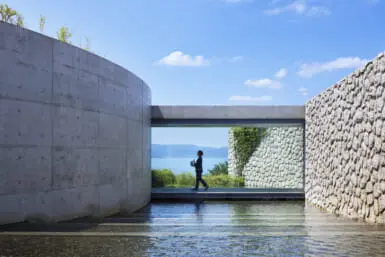With tourists flooding Japan’s major sightseeing spots this past year, many are searching for alternative, quieter areas to admire traditional culture and natural beauty in a more tranquil setting. If you are looking to escape Tokyo’s famous hustle and bustle for a weekend, you don’t even have to leave the prefecture.
Okutama — a town in western Tokyo, located an hour and a half from Shinjuku — is brimming with dramatic mountainscapes, seasonal flora and countryside warmth. It’s an ideal setting for experiencing satoyama, a Japanese word that literally translates to “mountain village.” This term has taken on a deeper philosophical meaning in recent years, referring to a sustainable environment that bridges the natural and human worlds, where people live in true harmony with nature.
Easily accessible by train, Okutama is just one of the picturesque towns dotting the Ome Line, a scenic rail line that runs in western Tokyo. It connects Tachikawa Station to Okutama Station, offering easy access to scenic natural spots and passing through a plethora of charming countryside areas on the way. The Ome Line is the site of the Ensen Marugoto Hotel Project, which envisions the entire railway line as a conceptual “hotel,” with station buildings and railroad facilities serving as “front desks.” The ultimate aim of this project is to share with the world these towns’ sustainable ecosystems, natural wonders and unparalleled hospitality.
Read on to find out more about some of the region’s best activities, dining opportunities and historical sites, all of which can be easily accessed from an Ome Line station.

Explore Okutama on a Cycling Tour
One of the best ways to bask in the stunning beauty of Okutama’s mountains is through a cycling tour. Trekkling, a bicycle rental shop located close to Okutama Station, offers English-guided tours on a reservation basis. As you pass through winding forest paths and peaceful riverside streets, the guide will introduce you to the history, culture, flora and fauna of Okutama.
The picturesque tour culminates at Lake Okutama, featuring turquoise waters with a halo of lush mountains. Okutama’s scenery is a sight to behold throughout the four seasons, but its fall foliage is especially enchanting; come November, vibrant shades of crimson, orange and yellow decorate and enhance the area’s abundance of greenery.

As you cycle around Okutama, one highlight not to miss is Shirahige Shrine. Tucked behind a torii gate close to Okutama Historical Road, the ancient shrine’s hushed silence adds to its sacred atmosphere. The immense limestone rock that leans over the shrine is in itself a sacred object: an iwakura, believed to be a dwelling place of the gods. It was designated a Tokyo National Monument in 1926.

Farm-to-Table Dining at Satologue
Nestled in the heart of Okutama, Satologue is a farm-to-table restaurant with an attached sauna facility that perfectly encapsulates satoyama culture. The restaurant, Tokiro (stylized as TOKIRO, with the meaning “The Way Back to Your True Self”), serves seasonal vegetables harvested from its own gardens as well as locally sourced fresh river fish. Chefs Komagamine Yuta and Takanami Kazuki use French techniques to craft delicate dishes that are both visually enchanting and unique in flavor.

Before dining, guests can step into the restaurant’s picturesque riverside garden, where the manager and chef explain more about organic farming methods, ingredients, and local history. Within Satologue’s grounds you’ll also find Fukisui (stylized as FUKISUI), a wood-fired sauna and open-air bath surrounded by greenery, a water bath drawn from the river and a private lounge for relaxation. Satologue is set to open a guest lodging building next spring for overnight stays.

Harvest and Taste Fresh Wasabi
Located in close proximity to Satologue, Tokyo Wasabi is a family-owned business that aims to share Okutama’s cherished wasabi tradition with the world. “Wasabi Brothers” Hitoshi and Tacchan and partner Momo-san manage a wasabi-themed food truck, Wasabi Shokudo, which can be found in front of Okutama Station on weekends. They also offer an English-guided “Wasabi Experience.” The trio is passionate about preserving and nurturing wasabi’s heritage, painstakingly restoring many old wasabi fields by hand.
While wasabi is a world-famous Japanese spice used in a plethora of dishes, not many are aware of its deep history, thoughtful harvesting process and true flavor. Momo and Hitoshi explain that wasabi farming is an ancient tradition in Okutama, as the plant requires pure mountain waters, mild temperatures and ample shade. The area’s porous terrain is perfect for the plants’ growth, allowing wasabi to soak up its mineral-rich waters.

You can unearth this culinary wonder yourself while taking in the quiet charm of a hidden wasabi field’s trickling waters and vivid sprouts. You will then sample freshly ground wasabi, which is milder and sweeter compared to store-bought wasabi, making it palatable even for those who avoid spicy flavors.

Musashi Mitake Shrine: Mountain Worship and Wolf Deities
Mount Mitake has long been a center of spiritual belief in Japan, attracting pilgrims from all over the country for over a thousand years. Located at its summit is Musashi Mitake Jinja Shrine, an ancient site of Shinto spirituality known for its connection to wolves. Ohguchimagami, a deified Japanese wolf, is said to have saved Yamato Takeru no Mikoto. Today, these deities are widely referred to as Oinusama, attracting worshippers with pet dogs.
If you don’t feel like hiking, you can take a scenic cable car ride up to the shrine and admire the breathtaking panorama of mountain ranges and beyond. At the gate and all around the shrine, you will see striking wolf statues, each with a different appearance and expression.
Aside from the cute pet dogs that can be found strolling around the shrine with their owners, you might also be able to spot a Japanese giant flying squirrel in the mountain’s dense forests.
Along the path from the cable car station to the shrine, you will find shukubo (shrine lodgings) with a history dating back to the Edo period. For centuries, these lodgings have offered hospitality to worshippers and priests traveling from afar, allowing them to rejuvenate their bodies and minds with baths and meals prepared using local ingredients.

Tour Tokyo’s Oldest Sake Brewery
Another must-visit site along the Ome Train Line is Ozawa Brewery near Sawai Station. Founded in 1702, the establishment boasts more than 300 years of history, making it the oldest shuzo (sake brewery) in the Tokyo region. Ozawa Brewery offers free guided tours to the public. This is a rare behind-the-scenes glimpse at the art of sake brewing, which has been practiced in Japan for thousands of years and was recently declared a UNESCO Intangible Cultural Heritage.
The brewery’s flagship brand, Sawanoi, inherits its name from the Sawai area. Located by the Tama River, Sawai is known for its mineral-rich waters; Sawanoi’s logo features a sawagani (freshwater crab) symbolizing purity. Indeed, one of the brewery’s secrets to centuries of success is a horizontal well that supplies mineral-rich spring water. The building maintains its original wooden structure with thick earthen walls, naturally preserving the sake with stable temperatures.

It’s not just its environment that makes Ozawa Sake Brewery special; it’s also known for its reverent and conscientious approach to brewing. The kurabito (brewery workers) start each day by praying at a shrine atop the brewery gate, and complete each step of the long brewing process with great care. The external layers of rice grains that are shed during the meticulous “polishing” process, high in protein and fats, are repurposed for various foods like dango and for farming.
After the tour, check out the shops, restaurants and sake tasting options within the brewery’s attached garden, right by Tama River.

Nipponia Kosuge: Traditional Farmhouse Stay
Only about a 30 minute drive from Okutama, the last station of the Ome Line, Nipponia Kosuge Village in Kosuge, Yamanishi Prefecture, makes for a restful stay after a long day of adventures. This upscale inn blends the rustic charms of a 150-year-old wooden farmhouse with stylish modern design accents and comfortable amenities. Affectionately referred to as “A Village of 700 People In A Hotel,” Nipponia Kosuge runs on the warm support of village locals.

The spacious rooms at the inn’s main house are perfect for families and couples looking to escape the city and immerse themselves in an idyllic, rusting setting. Featuring an intentional fusion of modernist furniture and old fixtures, the cabin-style lofts evoke nostalgia and wonder. Guests can also participate in a walk around town with a local guide, and soak in an outdoor hot spring bath nearby.

At Genryu Kaiseki 24Sekki, an intimate fine-dining restaurant attached to the main house, you can sample creative cuisine incorporating fresh local ingredients. The restaurant also serves a Japanese-style room service in the morning, composed of nutritious vegetables, proteins and steaming miso soup.
Whether you briefly stop by Nipponia while traveling western Tokyo, or decide to relax there for a few days, the hotel is sure to be a memorable experience.
For more information about the Ensen Marugoto Hotel Project along the Ome Line, head to their Instagram.
For information about Satologue, check out their website and Instagram.
More Info
Satologue
Lunch: 11:00–12:45, 13:30–15:15
Sauna: 9:00–12:00, 12:30–15:30
Closed: Tuesday, Wednesday
T: 0428-85-9310
Services and hours may be subject to change after the opening of the accommodation building.
Trekkling cycling tours and rentals
Business hours: 9:00–17:00
Closed: Monday and Tuesday (unless it’s a public holiday) or in cases of bad weather
Cycling season: March–December
T: 080-1024-4617
Tokyo Wasabi
Inquiries: info@tokyowasabi.com
Ozawa Sake Brewery
Brewery tours are free, but a reservation is required.
T: 0428-78-8215
More details here.











